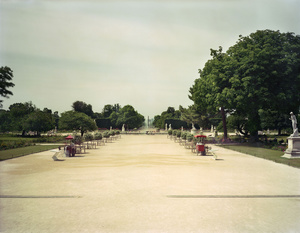
Jardin des Tuileries. 2013
History of photography is closely tied to Paris, place of experiments of its pioneers.
History of photography is closely tied to Paris, place of experiments of its pioneers. I came across the “ Inconnu du boulevard du Temple ” that Daguerre shot in 1838. A man immobilized on a boulevard, while his boots were being polished: he was for a long time considered as the first human figure recorded on a picture. Other documents have now changed this interpretation, but Daguerre’s photography still remains a symbol. Alone among the crowd that vanished on the plate, the Inconnu du boulevard du Temple represents the limits of early photographic process to fix any move, unable to produce accurate pictures of a world in action.
These modest masters with posthumous success fascinate by the artistic value of their documents. Even though their authors (Atget for instance) were looking on the documentary aspect of things more than anything else. Their work , amazingly modern, is an inexhaustible source of inspiration for every landscape photographers.
That was my starting point. 175 years later. With a large format camera and with filters allowing me to lengthen considerably the time of exposure. A simple technical yet determining process since it’s closely tied to the history of photographic process itself. I think that for photographers of my generation the digital matter and its manipulation is an endless issue in the photographic act and in its final presentation.
I wanted to photograph time that passes. The crowd ends up disappearing. Paris is emptying itself here and there, some silhouettes appear, as floating souls wandering in Purgatory.
This work is part of «France(s) Territoire Liquide », forty-three photographers commissioning themselves to rediscover France and depict its landscapes, thirty years after the Mission Datar. Forty-three photographic projects under the artistic guidance of Paul Wombell.